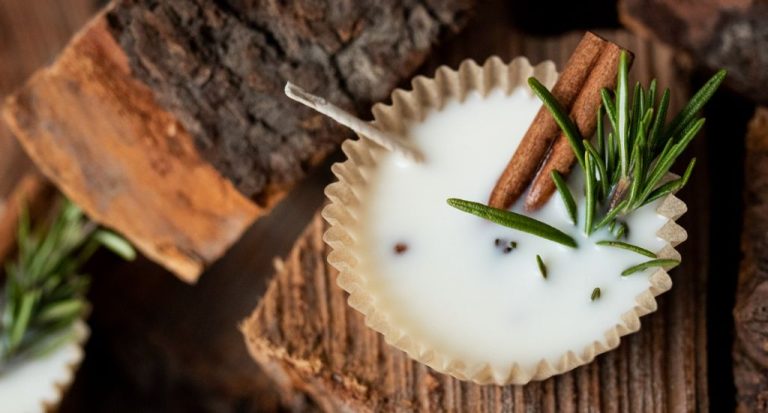Can You Decorate Pillar Candles?
Pillar candles are tall, cylindrical candles that stand upright on their own without the need for a holder. They come in a variety of sizes, from small votives to large pillars several feet tall (Pureintegrity.com).
Pillar candles are popular for their classic, elegant look and long-burning capability. They are commonly used for decorative purposes, to create ambiance, for religious ceremonies, or as gifts (Creativecandles.com).
Compared to other candle forms like tapers or votives, pillar candles tend to burn slower and more evenly. This is due to their thicker diameter and the larger wax pool. Pillars don’t require holders or constant maintenance like other types, making them very convenient. Their long-lasting burn time and freestanding shape make them a popular choice for home decor and events (Creativecandles.com).
Supplies Needed
To decorate pillar candles, you will need the following supplies:
Wax
The most common types of wax used to make decorative pillar candles are paraffin wax and soy wax. Paraffin wax is derived from petroleum and is inexpensive and easy to work with. Soy wax is made from soybeans and is a renewable and eco-friendly option. Both produce quality candles.
Wicks
Make sure to use the proper wick for the thickness and diameter of your pillar candle. Using the wrong wick can lead to tunneling or an uneven burn. Common wick materials include cotton, paper, and zinc.
Fragrance Oils
Fragrance oils are concentrated scents that are added to the wax to give the candle its aroma. Some popular fragrances for decorative pillar candles include floral, fruit, and baking scents.
Molds
Pillar candle molds come in a variety of shapes and sizes. You can find basic round and square molds, as well as shaped molds for decorative styles.
Double Boiler
A double boiler allows you to melt the wax safely at the proper temperature. You can purchase one or create your own by using two pots.
Dyes and Glitter

Liquid candle dyes and glitter are used to add color and create decorative effects in the wax.
Preparing the Wax
When decorating pillar candles, it’s important to start with the right type of wax. Look for wax made specifically for container candles, as these are blended to be harder and hold their shape when cool (1). Paraffin, soy, or bee’s wax can all be used. Avoid softer wax like gel candles as these will not setup properly on a pillar candle.
To melt wax for decorating, it’s safest to use a double boiler on the stove. This allows you to evenly melt the wax at a low temperature to preserve the integrity of the wax. Make sure all utensils touching wax are metal, glass, or ceramic. Place wax in the top pan of a double boiler and fill the bottom with an inch or two of water. Heat the water to a simmer and stir the wax regularly as it melts. Remove from heat when the wax is fully melted and pour into a heat safe pouring container (2).
Allow the wax to cool slightly so it thickens to a syrupy consistency. The temperature should be around 175-185°F before decorating. If the wax cools too much, gently reheat to reach the optimal temperature. Making sure the wax isn’t too hot will allow time for working before it sets up.
(2) https://suppliesforcandles.co.uk/candle-college/best-ways-to-melt-candle-wax
Adding Fragrance
One of the most important steps in decorating pillar candles is adding fragrance, as this will determine how your finished candle will smell. There are two main types of fragrance oils used in candle making – paraffin-based and natural fragrance oils.
Paraffin-based fragrance oils are synthetic fragrances dissolved in a paraffin wax base. They tend to be stronger scented and more cost effective. However, some people prefer natural fragrances for a more subtle, natural aroma. Natural fragrance oils are extracted from plants and flowers. They produce a lighter scent but are usually more expensive.
When adding fragrance oil to wax, a general guideline is to use 5-10% fragrance oil by weight of the wax. For example, for 1 kg of wax, use 50-100g of fragrance oil [1]. Adding too much fragrance can make the candle smell overpowering or even create an oily residue on the melted wax. It’s best to start with less and increase if needed.
To add fragrance, first melt your wax completely. Then measure out the desired amount of fragrance oil and stir it in thoroughly to fully blend with the wax. Allow the wax to re-harden before pouring into the pillar candle mold.
Coloring the Wax
There are a few main types of candle dyes that can be used to color pillar candles – liquid, powder, and block dyes. Each has their own advantages and disadvantages.
Liquid dyes are very concentrated, so only a small amount is needed. Typically start with 1/8 tsp per pound of wax and adjust as needed. They mix easily into wax but can stain skin and surfaces.1
Powder dyes are also very concentrated and a little goes a long way. Use around 1/16 tsp per pound of wax. They dissolve well but can clump if not mixed thoroughly. Powder dyes can also stain.1
Block dyes are less concentrated so more is needed to achieve bold colors, around 1-2 tbsp per pound of wax. They won’t stain but take longer to melt and incorporate. Shave or grate block dye before adding to wax.1
No matter which type of dye, always test a small amount first to achieve the desired color saturation before adding to a larger batch.
Pouring the Candles
Proper preparation of the mold is crucial for cleanly pouring pillar candles. Make sure to prep the mold by spraying it with a mold release or wiping it down with alcohol to prevent the candle from sticking. Silicone molds don’t require a release agent. According to this source, pour your wax when it has cooled to 100-135°F to avoid sink holes and an uneven finish. Pour your wax slowly and steadily in one spot at the edge of the mold to minimize bubbles. Allow the poured candle to cool undisturbed for at least 6 hours before attempting to remove it from the mold. This will give the wax time to completely set up and prevent cracking or crumbling.
Decorative Techniques
There are many creative ways to decorate pillar candles to make them unique. Some popular techniques include:
Embeds allow you to press objects into the wax while the candle is still warm. You can embed dried flowers, herbs, seeds, glitter, beads, sea shells, and more. Make sure any objects are heat resistant. Press gently so the objects are partially submerged in the wax. Let the candle fully cool and cure before burning (Source).
Spraying the surface of cooled wax with glitter spray or shimmer spray is an easy way to add a lovely sheen. Metallic spray paints work well too. Lightly dust the surface, let dry, and spray a sealant if desired (Source).
Painting candles allows for great creativity. Acrylic craft paints work best. Paint designs, patterns, words, or scenes on the candles before or after pouring into containers. Make sure the paint is completely dry before burning. Seal with a spray sealer for longevity (Source).
Making Wicks
The type of wick you use is crucial for proper candle burning. Wicks are typically made from materials like cotton, hemp, or wood. Cotton wicks are common and work well for most candles. Hemp wicks are great for soy candles since they burn cleaner. Wooden wicks make crackling sounds as the wood burns, creating ambiance.
To make basic cotton wicks, braid together three cotton yarn strands for stability. You can treat the wick with wax or zinc to help it stand upright in the melted wax. Some wick options come pre-treated. It’s also important to choose the right wick thickness for the candle diameter. A wick that is too thin will tunnel the candle, while one too thick can create excess soot. Testing different wick sizes to find the best burn for your wax type is recommended.
Wicking the candle involves securing the wick to the bottom of the container so it stands centered and upright when pouring in wax. You can adhere it with hot glue, use wick stickers, or utilize a wick bar system. Having the centered wick in place ensures proper burning through the full depth of the pillar candle.
Curing the Candles
Proper curing is an essential step when making candles. Curing refers to allowing time for the candle wax and fragrance to fully bind and integrate together before burning (Importance of Curing – Late Harvest Candle Co.). During the curing process, the candle becomes denser as molecules within the wax align and crystallize. This helps the candle burn slower and more evenly.
How long you cure a candle depends on the type of wax. Paraffin candles need 1-2 weeks to cure properly. Soy and beeswax candles require a longer curing time of 2-4 weeks. Curing candles in a cool, dry area away from drafts produces the best results. You can cure candles with lids on or off, but lids on helps retain fragrance. Be patient during curing for high quality, long burning candles.
Safety Tips
Proper ventilation and avoiding fires are critical for safe candle making and burning. Here are some key tips:
Make sure the area has good airflow and ventilation to prevent buildup of flammable wax vapors (Northwood Candle Supply). Open windows, use fans, or make candles outside.
Wear proper clothing like long sleeves, pants, and closed-toe shoes to prevent burns from hot wax (Lonestar Candle Supply). Tie back long hair.
Work on a non-flammable surface like stainless steel, tile, or concrete. Avoid surfaces like wood or plastic that can melt.
Keep baking soda on hand to extinguish wax fires. Never use water which can cause splattering.
When burning candles, keep them away from flammables like curtains, books, or furniture. Trim wicks to 1⁄4” before lighting to prevent big flames.
Never leave burning candles unattended. Extinguish before going to bed or leaving the house.



